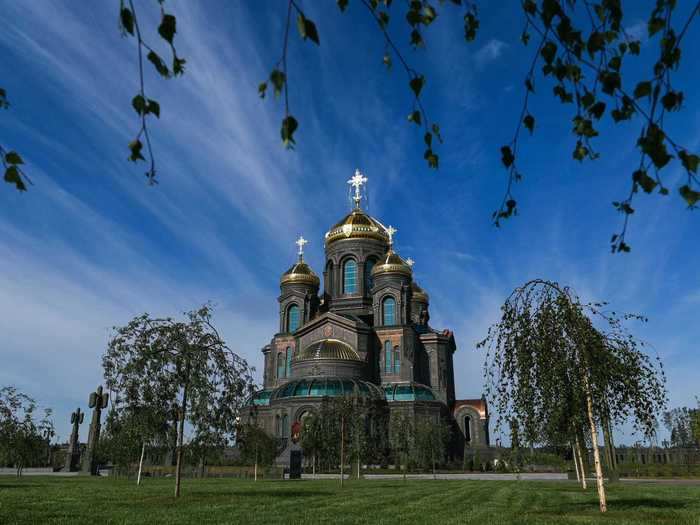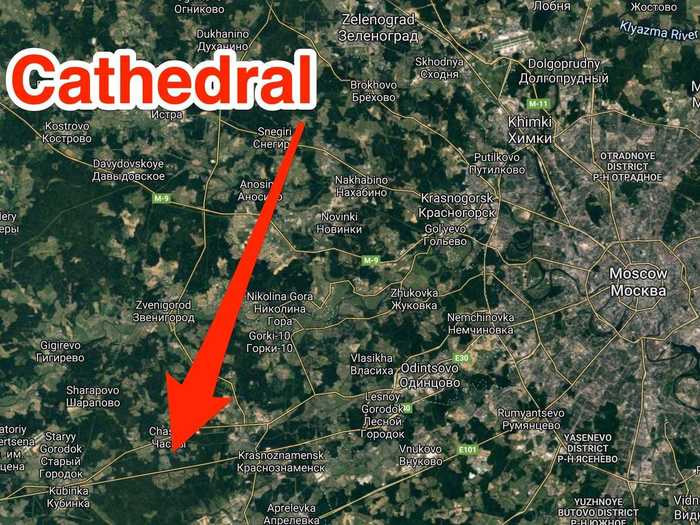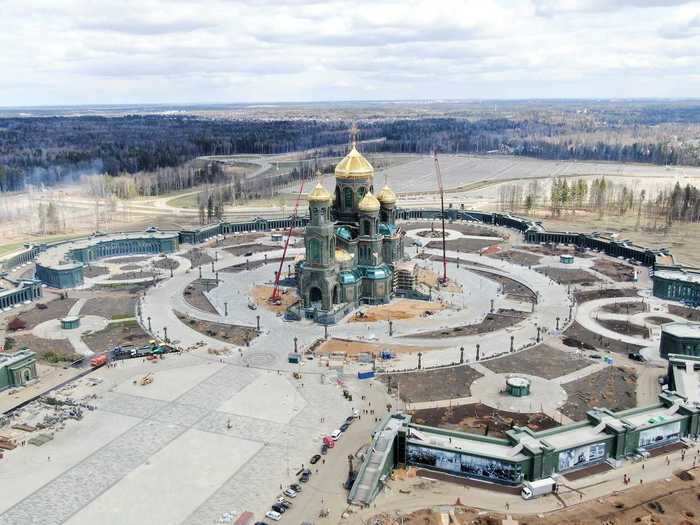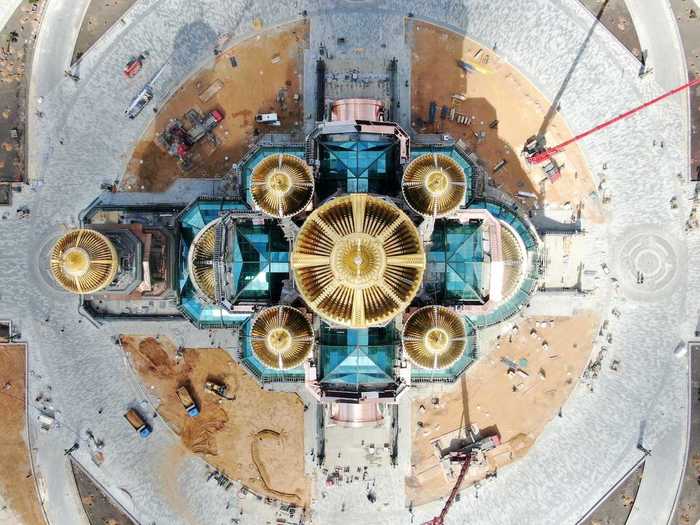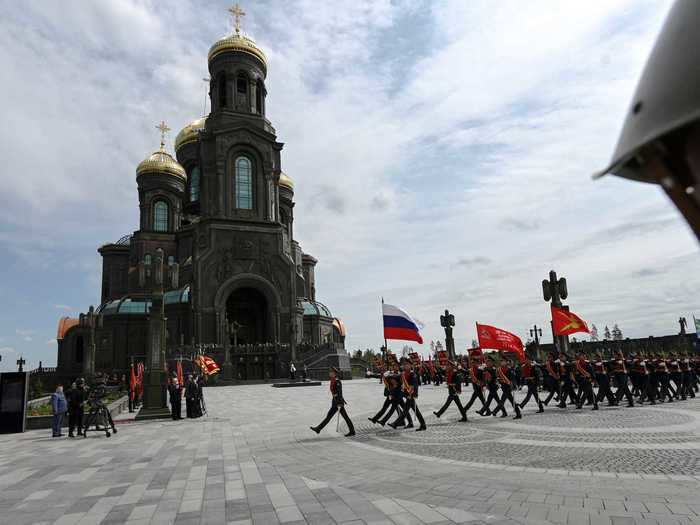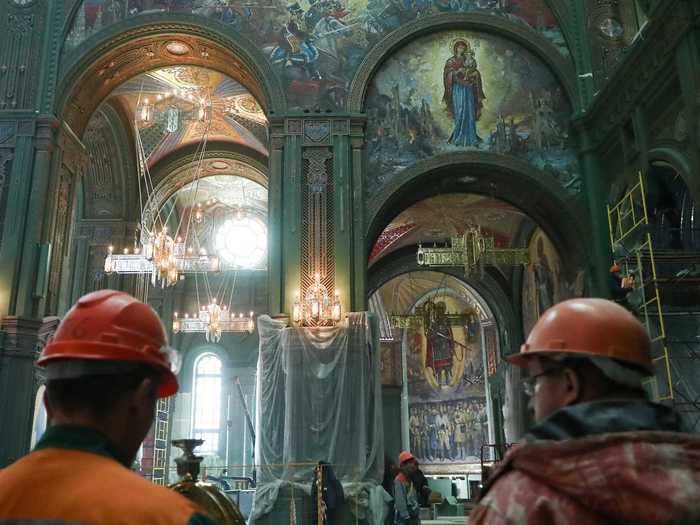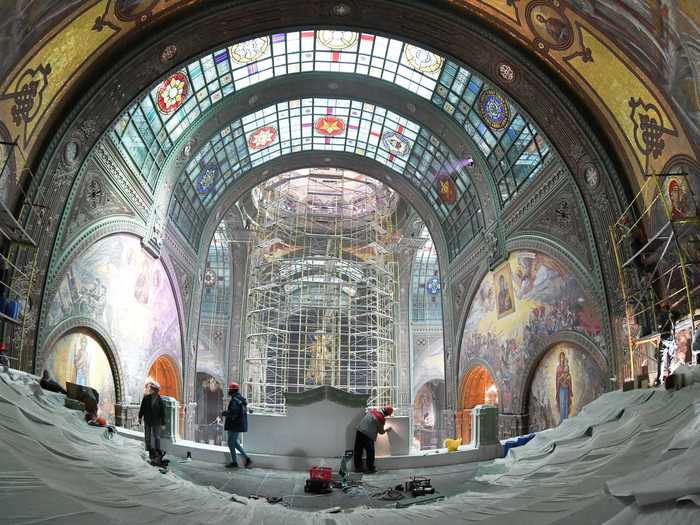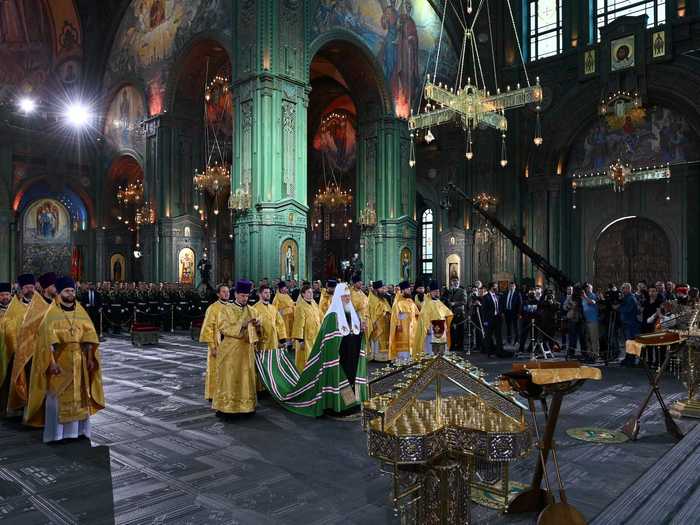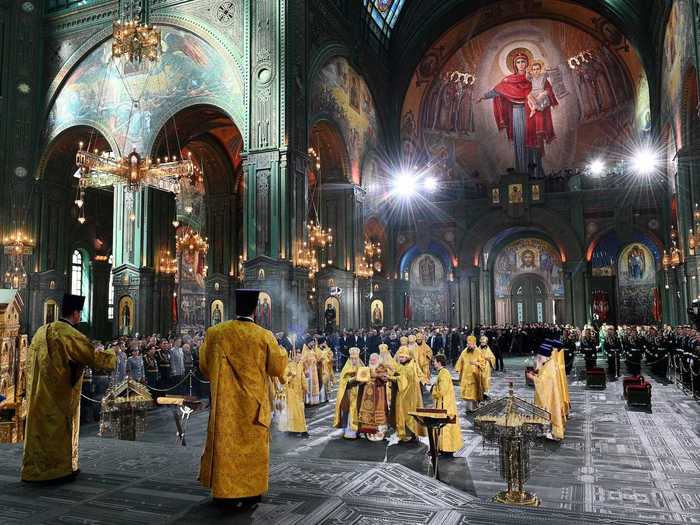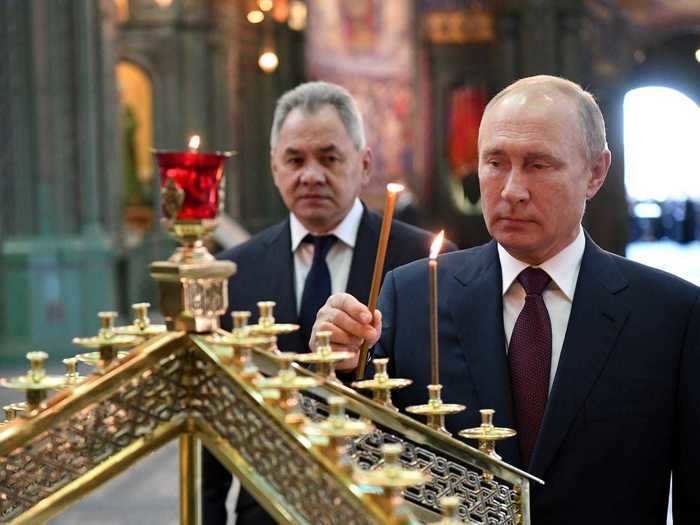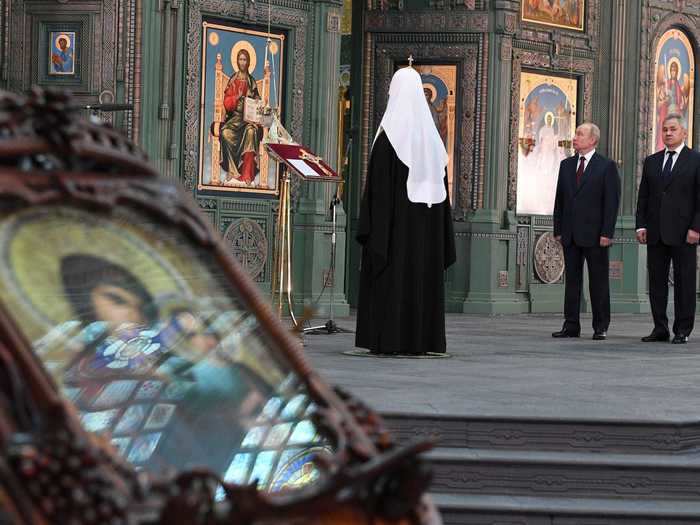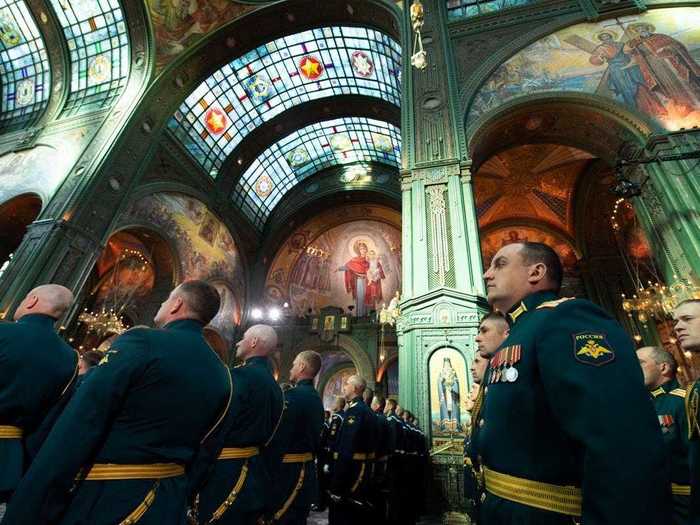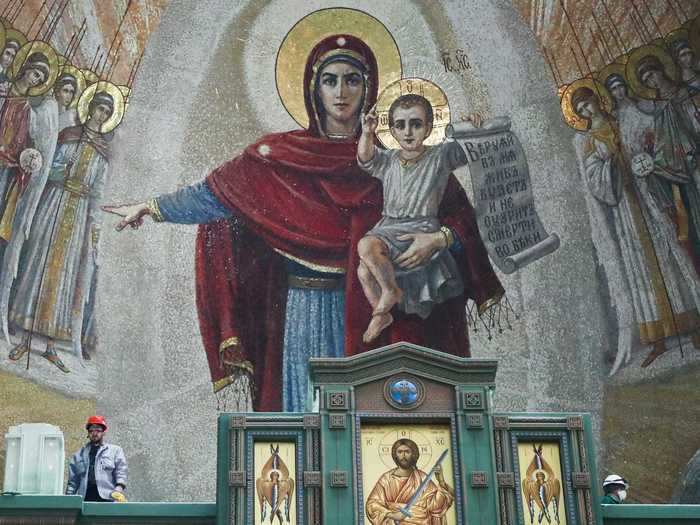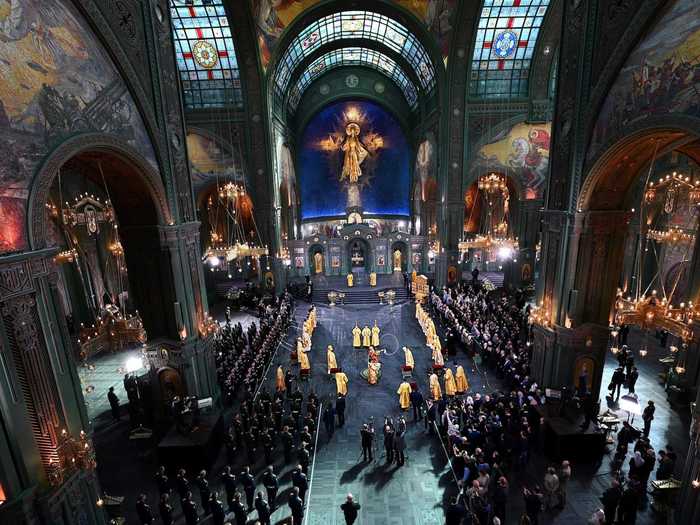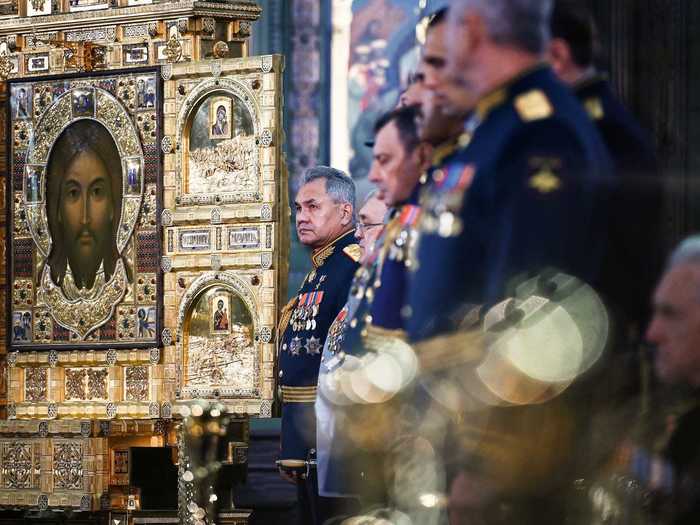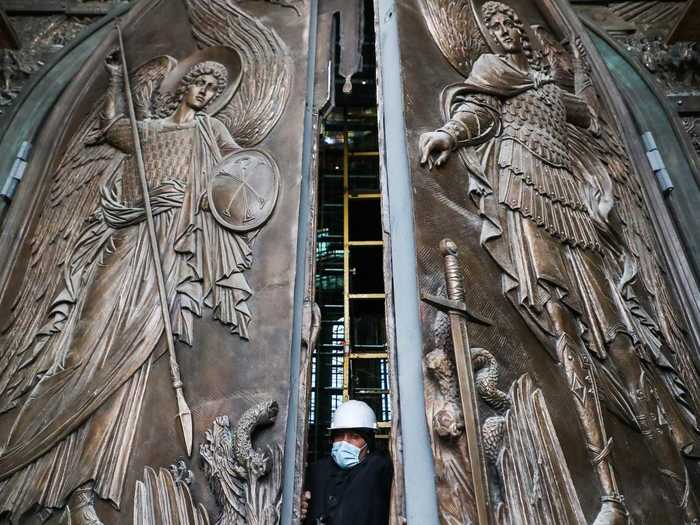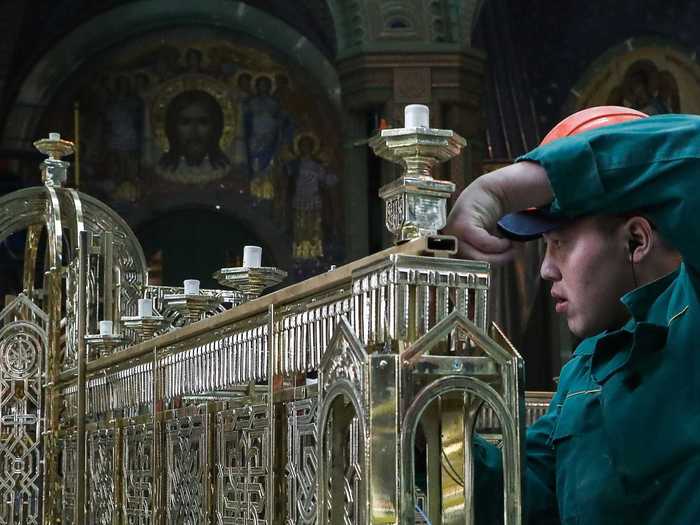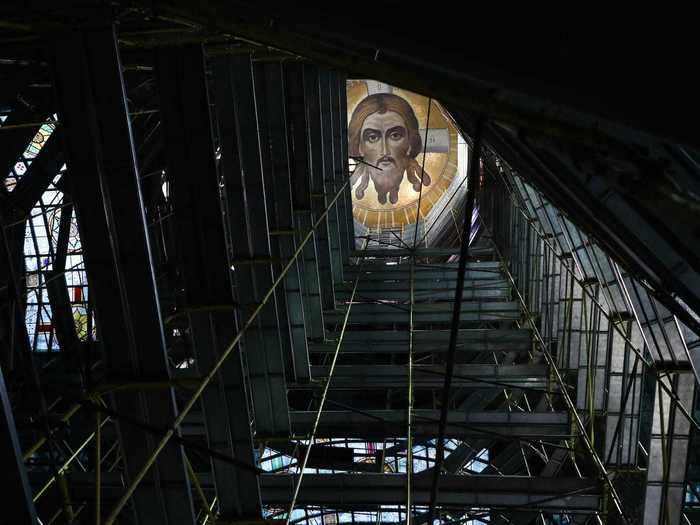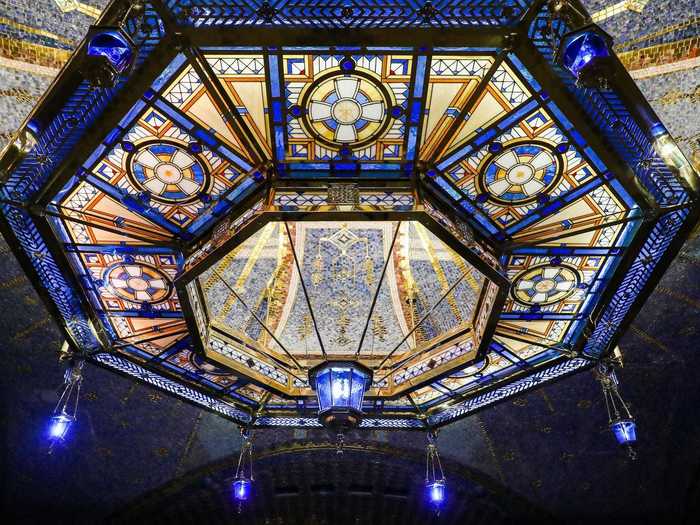An aerial view of the Main Cathedral of the Russian Armed Forces during its construction outside Moscow, Russia April 28, 2020.Denis Voronin/Moscow News Agency/Handout via Reuters
- Russia has just opened a massive cathedral in honor of its military, a major project favored by President Vladimir Putin.
- The cathedral serves the Russian Orthodox faith. Its military connection is no coincidence.
- Putin has made the glorification of the military a major part of his appeal to Russian voters throughout his 20-year leadership.
- The opening of the cathedral overlaps with a referendum that could see Putin remain as president until 2036.
- When the project was announced, Russia's defense minister promised the steps would be poured from "German trophy hardware" — rumored to be a reference to melted-down Nazi tanks.
- The building is filled with symbolism in honor of Russia's military history — but also caused controversy with a planned mosaic of Putin that was ultimately canceled.
Russia has just built a huge cathedral in honor of its military to commemorate 75 years since the end of WWII.
The Main Cathedral of the Russian Armed Forces, June 14, 2020.
Igor Palkin/Patriarchal Press Service/Handout via Reuters
Its full title in English is: The Resurrection of Christ Cathedral, the main Russian Orthodox Cathedral of Russian Armed Forces.
The cathedral is about 34 miles west of Moscow in a complex called Patriot Park.
A map showing the location of the cathedral.
Google Maps/Business Insider
Each of its four chapels is dedicated to a different patron saint of the branches of the Russian armed forces — the aerospace forces, the missile forces, the navy and the land army.
Source: Cathedral website.
It was built in just under 600 days, but was slightly delayed due to the coronavirus pandemic.
An aerial view shows the cathedral during construction works in April 28, 2020.
Denis Voronin/Moscow News Agency/Handout via
It was supposed to be consecrated on May 9, which is Victory Day in Russia, but due to the coronavirus this was rescheduled to June 14, according to Radio Free Europe.
The building is said to have cost $82 million. The cathedral says around half of this came from donations.
An aerial view shows the cathedral under construction on April 28, 2020.
Denis Voronin/Moscow News Agency/Handout via Reuters
The church's website says the $43 million came from public donations.
According to the independent news outlet Znak.com, another $42.5 million came from Moscow public funds.
The cathedral was consecrated on June 14 with a large-scale military and religious ceremony.
Russian Army servicemen march during a service to consecrate the cathedral on June 14, 2020.
Igor Palkin/Patriarchal Press Service/Handout via Reuters
The cathedral serves the Russian Orthodox faith, the most widespread religion in the country.
Workers in the cathedral under construction.
Anton Novoderezhkin/TASS via Getty Images
Here is an interior view of the construction work inside the cathedral.
An interior view of the cathedral under construction in April.
Sergei Kiselyov/Moscow News Agency/Handout via Reuters
Patriarch Kirill — the Russian Orthodox Church's supreme leader — led the consecration.
Patriarch Kirill leads a service consecration of the cathedral on June 14, 2020.
Igor Palkin/Patriarchal Press Service/Handout via Reuters
Here's another scene from the consecration, featuring a massive mosaic of the Virgin Mary and child.
Patriarch Kirill leads the consecration.
Sergei Vlasov/Patriarchal Press Service/Handout via Reuters
This is an important project for Putin, who visited on June 22 — three days before Russians set out to vote on major constitutional reforms that will likely consolidate his power.
Russia's President Vladimir Putin and Defense Minister Sergei Shoigu visit the cathedral on June 22, 2020.
Sputnik/Alexei Nikolsky/Kremlin via Reuters
When he announced the project in September 2018, Putin said it would be "one more symbol of the indestructibility of our national traditions, of our loyalty to the memory of our forefathers and their achievements," according to The Times of London.
Over his 20 years as either Prime Minister or President of the Russian Federation, he has long glorified the military.
The constitutional reforms could potentially see Putin remain leader until 2036.
Putin, Shoigu and Patriarch Kirill of Moscow and All Russia visit the cathedral on June 22, 2020.
Sputnik/Alexei Nikolsky/Kremlin via Reuters
The proposed reforms would limit a president's rule to a total of two six-year terms (Putin is currently on his fourth).
However, it would also "reset the clock" on Putin's own rule, the BBC reported, potentially giving him another 12 years beyond the end of his current term in 2024.
The final day of voting will be July 1.
Some religious figures have condemned the mixing of religion and military.
Army officers attending the consecration.
Russian Defence Ministry/Moscow News Agency/Handout via Reuters
Critics such as Andrey Kuraev, a former high-ranking clergyman who was expelled from the church, told Al-Jazeera that the cathedral was built to glorify a secular "cult of victory."
It's not the only controversy around the cathedral.
The cathedral became mired in controversy in late April when pictures emerged of a mosaic depicting Putin himself adorning the walls.
The mosaic showed Putin alongside defence minister Sergei Shoigu and other top officials.
Another part of the mosaic showed a group of women with the words "Crimea is ours" above them, according to the Independent.
This was in reference to the Russia's annexation of the Crimean peninsula of Ukraine in 2014.
The Orthodox church defended the mosaic as depicting one of many historical scenes, but ultimately it was cancelled.
A worker stands in front of a half-finished religious mosaic during the cathedral's construction.
Anton Novoderezhkin/TASS via Getty Images
A church official said on May 1 that the mosaic was ditched at to Putin's request, according to The Guardian.
A Kremlin spokesperson said: "Someday our thankful descendants will appreciate our merits, but it's too early to do so now," the paper reported.
The massive cathedral still has numerous symbolic features glorifying Russian history.
General view of the service consecrating the cathedral on June 14, 2020.
Igor Palkin/Patriarchal Press Service/Handout via Reuters
On the left is Defense Minister Sergei Shoigu at the consecration. When the project was announced in 2018, he said the steps would be made from "German trophy hardware," according to The Times.
Russian Defence Minister Sergei Shoigu attends the consecration.
Igor Palkin/Patriarchal Press Service/Handout via Reuters
This has been widely reported as having been made from Nazi tanks. The BBC dubbed it a "Game of Thrones" cathedral, in reference to the series' Iron Throne made of the swords of defeated enemies.
Metals feature heavily throughout the building's construction, such these doors.
A worker at the doors of the construction site.
Anton Novoderezhkin/TASS via Getty Images
Here is a worker helping to install intricate ornamentation to be hung from the ceiling during the cathedral's construction.
A worker in the Russian Armed Forces' main cathedral during its construction.
Anton Novoderezhkin/TASS via Getty Images
This mosaic of Christ's face, shown here during construction, is known as the Savior-Not-Made-By-Hands. It adorns the entire underside of the cathedral's biggest dome.
A giant mosaic of the Saviour Not Made by Hands under construction.
Anton Novoderezhkin/TASS via Getty Images
Other lavish decorations appear throughout.
A chandelier in the Russian Armed Forces' main cathedral.
Anton Novoderezhkin/TASS via Getty Images

